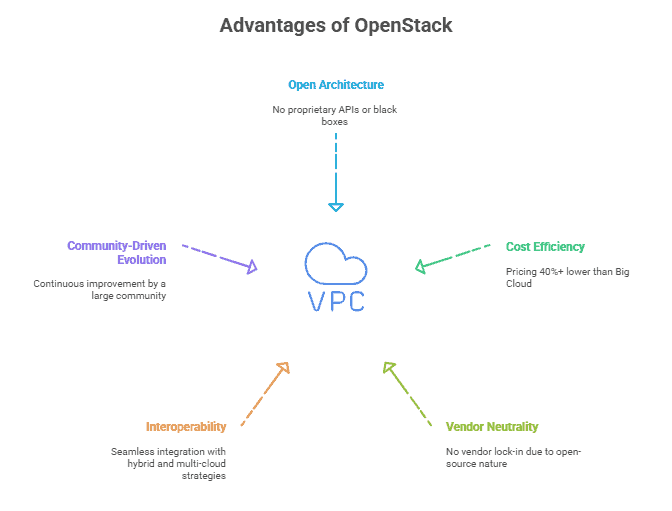Choosing the right cloud platform today is akin to trying to pick a needle out of a haystack. There are too many choices and not enough transparency. For many IT leaders, that complexity leads to vendor lock-in, inflated costs, and slow innovation.
In fact, according to Flexera’s 2024 State of the Cloud Report, 82% of enterprises cite managing cloud spend as their number one cloud challenge. It’s no longer just about scalability—it’s about cost, control, and clarity.
| “The modern enterprise no longer wants to be told how to build in the cloud; they want to build it their way.” ~Tim Timrawi, CEO of Sharktech |
If you’re exploring alternatives to hyperscalers or wondering whether OpenStack belongs in your cloud strategy, you’re in the right place.
In this blog, we’ll break down what the OpenStack public cloud is, who it’s for, and how to leverage it for real-world outcomes.
What is the OpenStack Public Cloud?
OpenStack public cloud is a service model where providers offer Infrastructure-as-a-Service (IaaS) based on the OpenStack open-source cloud platform.
Think of it as a customizable, cost-effective alternative to AWS, Azure, or GCP—but with a foundation built by a vibrant global community and governed by the OpenInfra Foundation.
OpenStack lets you provision compute, networking, and storage resources on demand, much like any other public cloud. The difference? You’re not paying a premium for brand names, and you’re not stuck with rigid configurations that serve the provider’s profit margins.
Why OpenStack Public Cloud Providers are Worth a Closer Look
While the big three cloud giants dominate the market, OpenStack public cloud providers are carving out a strong niche by focusing on flexibility, transparency, and open standards.
Top providers, such as OVHcloud, Limestone Networks, and VEXXHOST, offer public cloud environments that rival hyperscalers in performance, but with far more customization options.
What you gain is the power to build, migrate, or integrate your workloads without reinventing the wheel (or sacrificing control).
Is OpenStack a Public or Private Cloud?
OpenStack itself is a cloud infrastructure platform. It becomes a public or private cloud depending on how you deploy it.
Public cloud refers to a service that is hosted and offered to multiple users by a third-party provider.
Private cloud is an isolated infrastructure running OpenStack dedicated to and used by a single company. It can either reside on-prem or be hosted by a service provider.
This dual nature makes OpenStack uniquely versatile. You can build a private cloud in-house or plug into a public version hosted by a provider without changing your tech stack, or both.
The Top 5 Benefits of OpenStack Public Cloud for Businesses
The benefits of OpenStack public cloud for businesses are compelling, especially if you’re seeking performance and control without being shackled to a locked ecosystem:
- Open architecture – No black boxes, no proprietary APIs.
- Cost efficiency – Pricing tends to be 40%+ lower than Big Cloud.
- Vendor neutrality – no vendor lock-in due to the open-source nature of OpenStack.
- Interoperability – Seamless integration with hybrid and multi-cloud strategies.
- Community-driven evolution – OpenStack is being continuously improved by a large community, including such names as Red Hat and Rackspace.

According to the 2023 OpenStack User Survey by the OpenInfra Foundation, 72% of OpenStack users run mission-critical workloads on the platform, including applications in the telecom, finance, and healthcare sectors.
More articles you might like: |
How OpenStack Public Cloud Compares to Traditional Hyperscalers
Cloud public OpenStack platforms aren’t here to replace AWS, Azure, or Google Cloud. They’re here to offer alternatives that better fit many businesses’ needs.
While hyperscalers provide one-size-fits-most platforms, OpenStack-based public clouds offer:
| Feature | Hyperscalers | OpenStack Public Cloud |
|---|---|---|
| Pricing Transparency | Often complex | Clear and simple |
| Vendor Lock-in Risk | High | Low |
| Customization Options | Limited | Highly flexible |
| Community Ecosystem | Proprietary | Open-source driven |
| Multi-cloud Strategy | Complicated | Fully compatible |
If your needs include compliance, cost control, or specialized performance tuning, OpenStack may offer the edge you’re looking for.
Quick Guide: Choosing an OpenStack Public Cloud Provider
| Evaluation Factor | What to Look For |
|---|---|
| Service-Level Agreements | Clear uptime guarantees, response times |
| Location & Compliance | Data sovereignty and GDPR/CCPA considerations |
| Scalability | Ability to support future growth |
| Support Model | 24/7 support with technical depth |
| Pricing Transparency | No surprise fees or usage penalties |
How OpenStack-based Public Cloud Fuels Innovation
Choosing an OpenStack-based public cloud isn’t just about cutting costs. It’s about accelerating what your team can build.
From telecom firms rolling out edge services to research teams running high-performance clusters, OpenStack modular design means limitations never box you in. You can spin up environments that suit your workloads, whether that’s Kubernetes, Ceph storage, or anything in between.
Add native APIs, and your developers can automate the entire workflow, from provisioning to scaling, without relying on proprietary tools.
Choose Sharktech to Start Enjoying All the Benefits of OpenStack-based Public Cloud
When you’re ready to escape the gravitational pull of the hyperscalers and tap into the true potential of open infrastructure, Sharktech is your ideal launchpad.
| Trusted Cloud Services | |
Our OpenStack-based public cloud is designed for performance, scalability, and transparency, backed by a team that understands your business priorities. No hidden fees. No lock-in. Just cloud, your way.
Contact us today for a free consultation and discover how Sharktech’s OpenStack public cloud solutions can power your next chapter in digital transformation.




More to Read
The OpenStack Public Cloud Complexity Problem (And Why It’s Costing You)
Choosing the right cloud platform today is akin to trying to pick a needle
Oct
Make Growth and Security Part of Your Public Cloud Management Strategy
Managing today’s cloud infrastructure is no longer just about spinning up servers or
Sep
Leading Cloud Service Providers Explained: Types, Benefits, and How to Choose
94% of businesses now use a cloud solution in some form. Whether it’s
Aug
What is Public Cloud? A Simple Guide For Businesses
What is public cloud? It’s a model of cloud computing where infrastructure and
Jul
What is Cloud Migration? A Practical Guide for Modern Businesses
What is cloud migration? It’s the process of moving digital assets—like data, applications,
Jul
Why Some Businesses Choose Self-Managed Cloud Instead
Cloud computing has revolutionized how businesses deploy, manage, and scale their digital infrastructure.
Apr